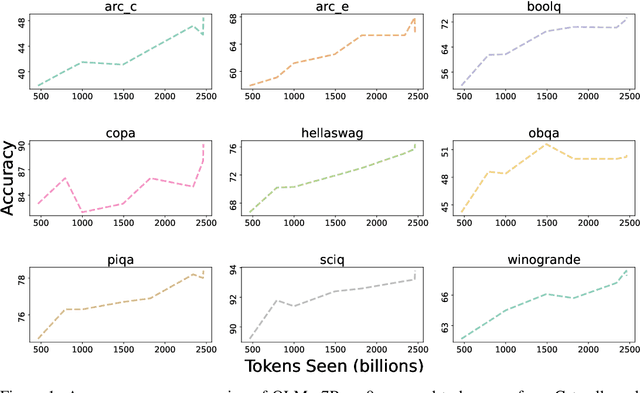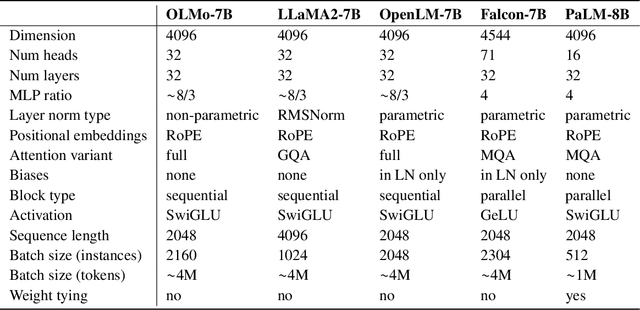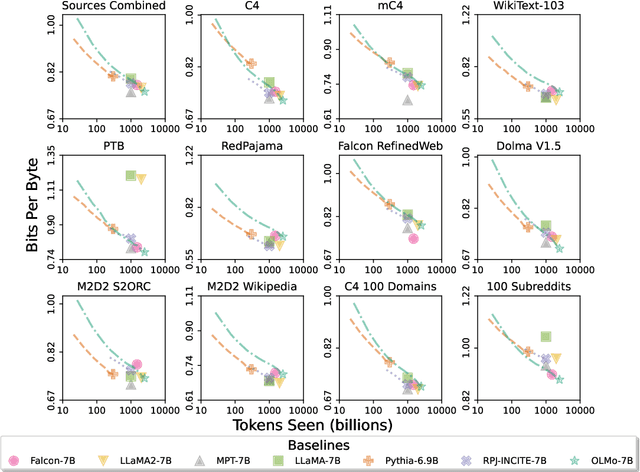Jack Hessel
Promptriever: Instruction-Trained Retrievers Can Be Prompted Like Language Models
Sep 17, 2024



Abstract:Instruction-tuned language models (LM) are able to respond to imperative commands, providing a more natural user interface compared to their base counterparts. In this work, we present Promptriever, the first retrieval model able to be prompted like an LM. To train Promptriever, we curate and release a new instance-level instruction training set from MS MARCO, spanning nearly 500k instances. Promptriever not only achieves strong performance on standard retrieval tasks, but also follows instructions. We observe: (1) large gains (reaching SoTA) on following detailed relevance instructions (+14.3 p-MRR / +3.1 nDCG on FollowIR), (2) significantly increased robustness to lexical choices/phrasing in the query+instruction (+12.9 Robustness@10 on InstructIR), and (3) the ability to perform hyperparameter search via prompting to reliably improve retrieval performance (+1.4 average increase on BEIR). Promptriever demonstrates that retrieval models can be controlled with prompts on a per-query basis, setting the stage for future work aligning LM prompting techniques with information retrieval.
WildVis: Open Source Visualizer for Million-Scale Chat Logs in the Wild
Sep 05, 2024Abstract:The increasing availability of real-world conversation data offers exciting opportunities for researchers to study user-chatbot interactions. However, the sheer volume of this data makes manually examining individual conversations impractical. To overcome this challenge, we introduce WildVis, an interactive tool that enables fast, versatile, and large-scale conversation analysis. WildVis provides search and visualization capabilities in the text and embedding spaces based on a list of criteria. To manage million-scale datasets, we implemented optimizations including search index construction, embedding precomputation and compression, and caching to ensure responsive user interactions within seconds. We demonstrate WildVis's utility through three case studies: facilitating chatbot misuse research, visualizing and comparing topic distributions across datasets, and characterizing user-specific conversation patterns. WildVis is open-source and designed to be extendable, supporting additional datasets and customized search and visualization functionalities.
Certainly Uncertain: A Benchmark and Metric for Multimodal Epistemic and Aleatoric Awareness
Jul 02, 2024



Abstract:The ability to acknowledge the inevitable uncertainty in their knowledge and reasoning is a prerequisite for AI systems to be truly truthful and reliable. In this paper, we present a taxonomy of uncertainty specific to vision-language AI systems, distinguishing between epistemic uncertainty (arising from a lack of information) and aleatoric uncertainty (due to inherent unpredictability), and further explore finer categories within. Based on this taxonomy, we synthesize a benchmark dataset, CertainlyUncertain, featuring 178K visual question answering (VQA) samples as contrastive pairs. This is achieved by 1) inpainting images to make previously answerable questions into unanswerable ones; and 2) using image captions to prompt large language models for both answerable and unanswerable questions. Additionally, we introduce a new metric confidence-weighted accuracy, that is well correlated with both accuracy and calibration error, to address the shortcomings of existing metrics.
How to Train Your Fact Verifier: Knowledge Transfer with Multimodal Open Models
Jun 29, 2024



Abstract:Given the growing influx of misinformation across news and social media, there is a critical need for systems that can provide effective real-time verification of news claims. Large language or multimodal model based verification has been proposed to scale up online policing mechanisms for mitigating spread of false and harmful content. While these can potentially reduce burden on human fact-checkers, such efforts may be hampered by foundation model training data becoming outdated. In this work, we test the limits of improving foundation model performance without continual updating through an initial study of knowledge transfer using either existing intra- and inter- domain benchmarks or explanations generated from large language models (LLMs). We evaluate on 12 public benchmarks for fact-checking and misinformation detection as well as two other tasks relevant to content moderation -- toxicity and stance detection. Our results on two recent multi-modal fact-checking benchmarks, Mocheg and Fakeddit, indicate that knowledge transfer strategies can improve Fakeddit performance over the state-of-the-art by up to 1.7% and Mocheg performance by up to 2.9%.
Selective Vision is the Challenge for Visual Reasoning: A Benchmark for Visual Argument Understanding
Jun 27, 2024



Abstract:Visual arguments, often used in advertising or social causes, rely on images to persuade viewers to do or believe something. Understanding these arguments requires selective vision: only specific visual stimuli within an image are relevant to the argument, and relevance can only be understood within the context of a broader argumentative structure. While visual arguments are readily appreciated by human audiences, we ask: are today's AI capable of similar understanding? We collect and release VisArgs, an annotated corpus designed to make explicit the (usually implicit) structures underlying visual arguments. VisArgs includes 1,611 images accompanied by three types of textual annotations: 5,112 visual premises (with region annotations), 5,574 commonsense premises, and reasoning trees connecting them to a broader argument. We propose three tasks over VisArgs to probe machine capacity for visual argument understanding: localization of premises, identification of premises, and deduction of conclusions. Experiments demonstrate that 1) machines cannot fully identify the relevant visual cues. The top-performing model, GPT-4-O, achieved an accuracy of only 78.5%, whereas humans reached 98.0%. All models showed a performance drop, with an average decrease in accuracy of 19.5%, when the comparison set was changed from objects outside the image to irrelevant objects within the image. Furthermore, 2) this limitation is the greatest factor impacting their performance in understanding visual arguments. Most models improved the most when given relevant visual premises as additional inputs, compared to other inputs, for deducing the conclusion of the visual argument.
WildChat: 1M ChatGPT Interaction Logs in the Wild
May 02, 2024Abstract:Chatbots such as GPT-4 and ChatGPT are now serving millions of users. Despite their widespread use, there remains a lack of public datasets showcasing how these tools are used by a population of users in practice. To bridge this gap, we offered free access to ChatGPT for online users in exchange for their affirmative, consensual opt-in to anonymously collect their chat transcripts and request headers. From this, we compiled WildChat, a corpus of 1 million user-ChatGPT conversations, which consists of over 2.5 million interaction turns. We compare WildChat with other popular user-chatbot interaction datasets, and find that our dataset offers the most diverse user prompts, contains the largest number of languages, and presents the richest variety of potentially toxic use-cases for researchers to study. In addition to timestamped chat transcripts, we enrich the dataset with demographic data, including state, country, and hashed IP addresses, alongside request headers. This augmentation allows for more detailed analysis of user behaviors across different geographical regions and temporal dimensions. Finally, because it captures a broad range of use cases, we demonstrate the dataset's potential utility in fine-tuning instruction-following models. WildChat is released at https://wildchat.allen.ai under AI2 ImpACT Licenses.
Selective "Selective Prediction": Reducing Unnecessary Abstention in Vision-Language Reasoning
Feb 23, 2024Abstract:Prior work on selective prediction minimizes incorrect predictions from vision-language models (VLMs) by allowing them to abstain from answering when uncertain. However, when deploying a vision-language system with low tolerance for inaccurate predictions, selective prediction may be over-cautious and abstain too frequently, even on many correct predictions. We introduce ReCoVERR, an inference-time algorithm to reduce the over-abstention of a selective vision-language system without decreasing prediction accuracy. When the VLM makes a low-confidence prediction, instead of abstaining ReCoVERR tries to find relevant clues in the image that provide additional evidence for the prediction. ReCoVERR uses an LLM to pose related questions to the VLM, collects high-confidence evidences, and if enough evidence confirms the prediction the system makes a prediction instead of abstaining. ReCoVERR enables two VLMs, BLIP2 and InstructBLIP, to answer up to 20% more questions on the A-OKVQA task than vanilla selective prediction without decreasing system accuracy, thus improving overall system reliability.
L3GO: Language Agents with Chain-of-3D-Thoughts for Generating Unconventional Objects
Feb 14, 2024Abstract:Diffusion-based image generation models such as DALL-E 3 and Stable Diffusion-XL demonstrate remarkable capabilities in generating images with realistic and unique compositions. Yet, these models are not robust in precisely reasoning about physical and spatial configurations of objects, especially when instructed with unconventional, thereby out-of-distribution descriptions, such as "a chair with five legs". In this paper, we propose a language agent with chain-of-3D-thoughts (L3GO), an inference-time approach that can reason about part-based 3D mesh generation of unconventional objects that current data-driven diffusion models struggle with. More concretely, we use large language models as agents to compose a desired object via trial-and-error within the 3D simulation environment. To facilitate our investigation, we develop a new benchmark, Unconventionally Feasible Objects (UFO), as well as SimpleBlenv, a wrapper environment built on top of Blender where language agents can build and compose atomic building blocks via API calls. Human and automatic GPT-4V evaluations show that our approach surpasses the standard GPT-4 and other language agents (e.g., ReAct and Reflexion) for 3D mesh generation on ShapeNet. Moreover, when tested on our UFO benchmark, our approach outperforms other state-of-the-art text-to-2D image and text-to-3D models based on human evaluation.
OLMo: Accelerating the Science of Language Models
Feb 07, 2024



Abstract:Language models (LMs) have become ubiquitous in both NLP research and in commercial product offerings. As their commercial importance has surged, the most powerful models have become closed off, gated behind proprietary interfaces, with important details of their training data, architectures, and development undisclosed. Given the importance of these details in scientifically studying these models, including their biases and potential risks, we believe it is essential for the research community to have access to powerful, truly open LMs. To this end, this technical report details the first release of OLMo, a state-of-the-art, truly Open Language Model and its framework to build and study the science of language modeling. Unlike most prior efforts that have only released model weights and inference code, we release OLMo and the whole framework, including training data and training and evaluation code. We hope this release will empower and strengthen the open research community and inspire a new wave of innovation.
Deal, or no deal ? Forecasting Uncertainty in Conversations using Large Language Models
Feb 05, 2024



Abstract:Effective interlocutors account for the uncertain goals, beliefs, and emotions of others. But even the best human conversationalist cannot perfectly anticipate the trajectory of a dialogue. How well can language models represent inherent uncertainty in conversations? We propose FortUne Dial, an expansion of the long-standing "conversation forecasting" task: instead of just accuracy, evaluation is conducted with uncertainty-aware metrics, effectively enabling abstention on individual instances. We study two ways in which language models potentially represent outcome uncertainty (internally, using scores and directly, using tokens) and propose fine-tuning strategies to improve calibration of both representations. Experiments on eight difficult negotiation corpora demonstrate that our proposed fine-tuning strategies (a traditional supervision strategy and an off-policy reinforcement learning strategy) can calibrate smaller open-source models to compete with pre-trained models 10x their size.
 Add to Chrome
Add to Chrome Add to Firefox
Add to Firefox Add to Edge
Add to Edge